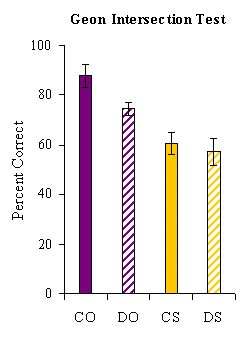|
|
| Disconnection of the geons in the original spatial
organization (DO) resulted in accuracy scores that did not differ from
the original objects (CO). The connected-scrambled (CS) and disconnected-scrambled
(DS) drawings were discriminated at a similar level of accuracy, which
was significantly poorer than the original drawings. The test results indicate
that the geon intersections were not a major contributor to object recognition.
These results are consistent with a study by Van Hamme, Wasserman, and
Biederman (1992). They trained pigeons to discriminate four objects in
which half of the contours and vertices were deleted. Then pigeons were
tested with complimentary contours which were in an intact or scrambled
arrangement. The complementary images were discriminated at a high level
of accuracy, but the scrambled contours were recognized much more poorly.
Their results indicated that the contours and geon intersections alone
were insufficient to account for successful object recognition. |

|
![]()